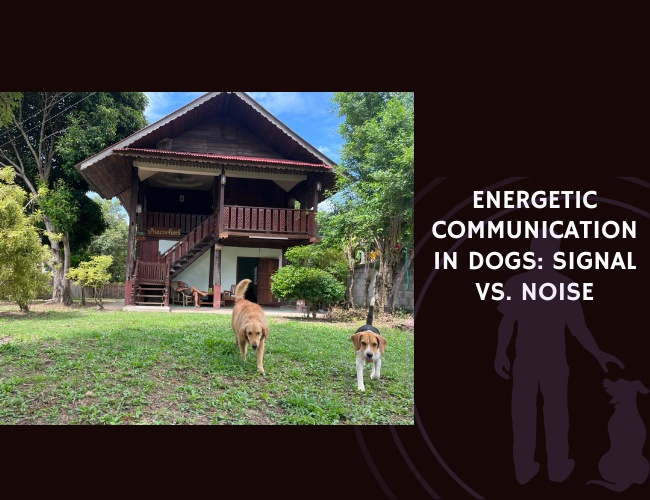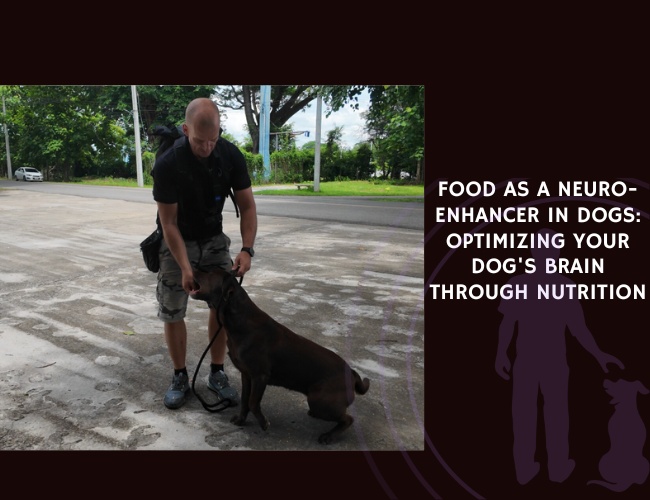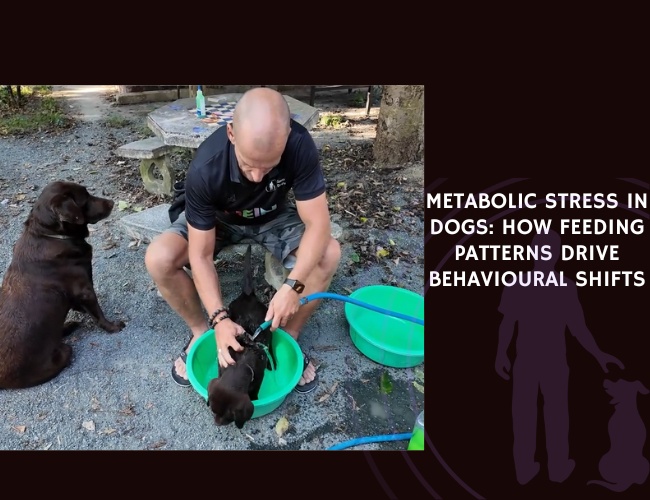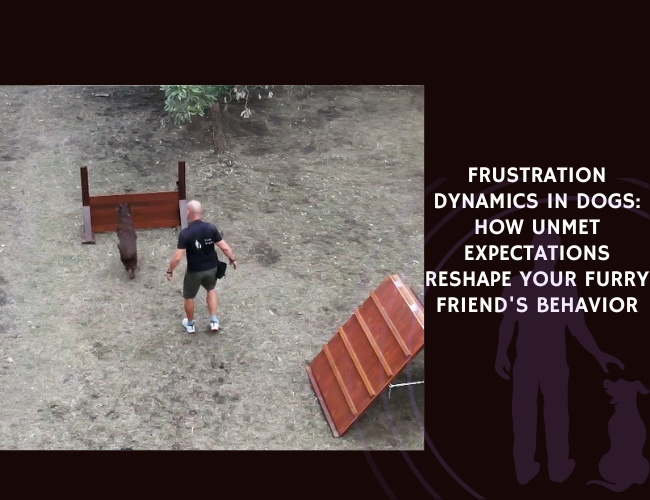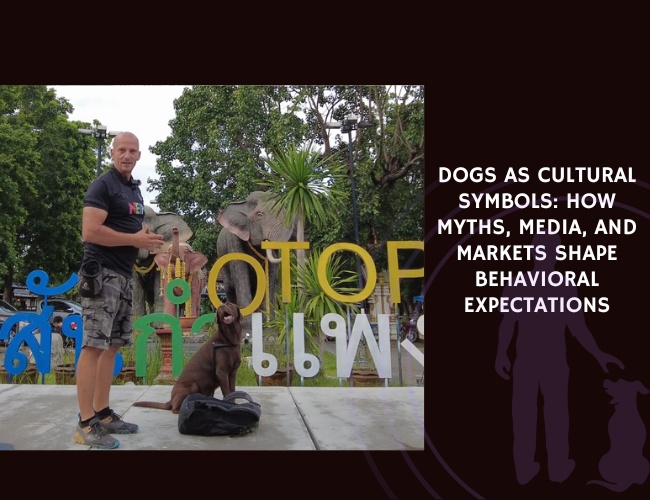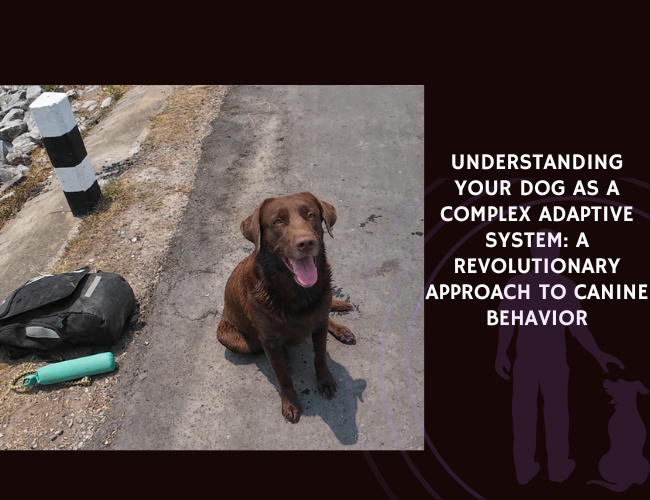Dissecting the Subtle Layers of Canine Intent, Presence, and Misinterpretation
Introduction
Have you ever noticed how your dog seems to know you’re anxious before you’ve said a word? Or wondered why some dogs respond beautifully to one trainer but struggle with another using the exact same commands? The answer lies in a fascinating realm of communication that goes beyond words, gestures, or even conscious thought—welcome to the world of energetic communication in dogs.
For centuries, we’ve known that dogs possess an uncanny ability to read human emotions. But what if we told you that this goes far deeper than simply recognizing a smile or frown? Dogs are masters at detecting and interpreting the energetic states of both humans and their fellow canines, creating a complex web of communication that operates on multiple levels simultaneously. Yet in our modern world, this delicate system of signals often gets lost in a sea of noise—from bustling dog parks to our own inconsistent body language.
Let us guide you through the intricate dance of canine energetic communication, where every breath, every subtle shift in posture, and every flicker of intent creates a message that your furry friend is expertly equipped to decode. Together, we’ll explore how to separate the meaningful signals from the overwhelming noise, creating clearer, more harmonious relationships with our four-legged companions. 🐾
Understanding Energetic Signals: The Foundation
What Constitutes a True Signal?
When we talk about energetic communication in dogs, we’re referring to something far more nuanced than simple body language. A true communicative signal involves the perfect synchronization of multiple elements:
Intent – The dog’s genuine emotional and behavioral intention Posture – The physical positioning and tension patterns throughout the body Breath – The rhythm, depth, and quality of breathing Gaze – The direction, intensity, and softness of eye contact Movement – The flow, speed, and purposefulness of motion
You might notice that when your dog is truly communicating—not just reacting—all these elements align like instruments in an orchestra. A relaxed greeting, for instance, involves soft eyes, rhythmic breathing, fluid movement, and a posture that says “I come in peace.” This is what researchers call an “energetic signature”—a unified message that transcends any single behavioral component.
The Science Behind the Signals
Recent advances in canine neuroscience have revealed fascinating insights into how dogs process these energetic communications. Mirror neurons—specialized cells that fire both when performing an action and observing it in others—play a crucial role. These neurons allow dogs to literally “feel” what you’re feeling, creating what scientists call limbic synchrony.
But here’s where it gets truly remarkable: dogs can detect changes in human heart rate variability (HRV), subtle shifts in cortisol levels through scent, and micro-expressions that last mere milliseconds. This means your dog often knows you’re stressed before you do! This incredible sensitivity evolved over thousands of years of domestication, making dogs uniquely attuned to human energetic states.
Energy Modulation in Different Contexts
Dogs are masters at adjusting their energetic output based on context. You’ll notice this in several scenarios:
During play – Energy levels spike and drop rhythmically, creating natural breaks In conflict situations – Energy may become tense and focused or deliberately lowered to de-escalate When bonding – Soft, steady energy promotes oxytocin release in both dog and human During work or training – Focused, directed energy that maintains clarity of purpose
Understanding these modulations helps us recognize when our dogs are truly communicating versus simply reacting to environmental stimuli. 🧡
The Canine Perception System: How Dogs Read Energy
Mirror Neurons and Emotional Mirroring
Did you know that when you’re anxious, your dog’s brain literally mirrors that anxiety? This isn’t just empathy—it’s a neurobiological phenomenon. Mirror neurons in the canine brain fire in patterns that match what they observe in their human companions. This creates an emotional feedback loop that can either amplify or soothe states of arousal.
This mirroring system is so sophisticated that dogs can detect:
- Subtle changes in muscle tension
- Variations in breathing patterns
- Micro-shifts in facial expressions
- Alterations in movement quality
What’s particularly fascinating is that this system operates largely below the threshold of conscious awareness. Your dog isn’t thinking “my human seems tense”—they’re experiencing a felt sense of that tension in their own body.
Limbic Synchrony and Social Referencing
The limbic system—the emotional center of the brain—doesn’t just process emotions; it synchronizes them between individuals. When you and your dog spend quality time together, your limbic systems begin to align, creating what researchers call “limbic resonance.” This is why calm owners tend to have calm dogs, and anxious owners often struggle with reactive pets.
Dogs also engage in social referencing, constantly checking in with their humans to gauge appropriate responses to new situations. You might notice your dog looking back at you when encountering something unfamiliar—they’re literally asking, “How should I feel about this?” Your energetic response provides the answer.
The Pre-Conscious Detection Window
Perhaps most remarkably, dogs often detect emotional and energetic shifts before they reach conscious awareness in humans. Research suggests dogs can identify these micro-signals:
10-20 milliseconds before a stress response becomes conscious Changes in scent that precede emotional shifts by several seconds Electromagnetic field variations (though this remains a controversial area of study) Subtle postural preparations for movement or action
This pre-conscious detection ability explains why dogs sometimes seem almost psychic in their responses to human states. They’re not reading minds—they’re reading bodies with extraordinary precision.
When Noise Drowns Out the Signal
Environmental Overwhelm: The Modern Challenge
Our modern world creates unprecedented challenges for canine energetic communication. Consider the average dog park—a cacophony of scents, sounds, movements, and conflicting energetic signals from dozens of dogs and humans. For a sensitive dog, this can be like trying to have a meaningful conversation at a rock concert.
Common sources of environmental noise include:
- Multiple dogs with conflicting energy states
- Human anxiety about dog interactions
- Overwhelming sensory stimulation (sounds, smells, movement)
- Territorial tensions and resource competition
- Inconsistent rules and boundaries
In these environments, dogs often shut down their receptive channels or become hypervigilant, making true communication nearly impossible. You might notice your usually responsive dog suddenly “going deaf” to your calls—they’re not being stubborn; they’re overwhelmed by noise.
The Mixed Signals Dilemma
One of the most significant sources of noise in dog-human communication comes from our own inconsistency. Consider this scenario: You’re calling your dog with a happy voice while your body radiates tension because you’re late for work. Your words say “come,” but your energy screams “stress!”
Common mixed signals include:
- Verbal praise with tense body language
- Calm words with rapid, jerky movements
- Affection delivered with underlying frustration
- Commands given without genuine intent or follow-through
These contradictions create what behaviorists call “learned confusion”—a state where dogs no longer trust the communication they’re receiving. Over time, this can lead to anxiety, reactivity, or apparent “stubbornness” that’s actually a coping mechanism for unclear communication.
Breaking Through Learned Confusion
When dogs have experienced prolonged exposure to mixed signals or inconsistent reinforcement, they develop protective patterns that can seem like behavioral problems. But these are actually adaptive responses to communication chaos. Signs of learned confusion include:
- Delayed responses to known commands
- Checking in excessively or not at all
- Stress signals during training (yawning, lip licking, looking away)
- Inconsistent performance of previously learned behaviors
The good news? Dogs are remarkably resilient and eager to establish clear communication channels. With patience and consistency, even deeply confused dogs can learn to trust energetic signals again. 🐾

The Neurobiology of Energetic Communication
Physiological Markers of Communication States
When dogs engage in true energetic communication, their bodies undergo measurable physiological changes. Understanding these markers helps us recognize when real connection is happening versus mere compliance or reaction.
Heart Rate Variability (HRV) represents the variation in time intervals between heartbeats. High HRV indicates a relaxed, receptive state where communication flows easily. Low HRV suggests stress or vigilance, making clear communication difficult. Remarkably, dogs and their bonded humans often show synchronized HRV patterns during positive interactions.
Cortisol and Stress Hormones fluctuate based on communication quality. Clear, coherent energetic signals actually lower cortisol levels in both dogs and humans. Conversely, mixed signals and communication noise elevate stress hormones, creating a biochemical barrier to understanding.
Oxytocin: The Bonding Hormone surges during positive energetic exchanges. Studies show that even brief moments of clear, intentional communication can trigger oxytocin release. This explains why some training sessions feel magical while others feel like battles—it’s not just about technique; it’s about energetic coherence.
Neural Circuits of Attention and Empathy
The canine brain has evolved specialized circuits for processing human communication. The temporal cortex, traditionally associated with auditory processing, shows increased activity when dogs observe human emotional expressions. But here’s the fascinating part: this activation occurs even in the absence of sound, suggesting dogs process our energy as a form of information.
Key brain regions involved include:
- The amygdala – Processing emotional salience and threat detection
- The prefrontal cortex – Integrating signals and making decisions
- The anterior cingulate cortex – Monitoring for conflicts between signals
- The mirror neuron system – Enabling emotional and motor mirroring
When these systems work in harmony, dogs can process incredibly subtle energetic communications. When overwhelmed by noise, these same systems can become hyperactive or shut down entirely.
Somatic Resonance and Felt Sense
Perhaps the most intriguing aspect of canine energetic communication is somatic resonance—the phenomenon where dogs physically feel human emotional states in their own bodies. This goes beyond empathy to a form of embodied communication that operates through:
Muscular mirroring – Dogs unconsciously tense muscles that correspond to human tension patterns Breathing synchronization – Respiratory rates naturally align during calm interactions Postural echoing – Dogs adopt body positions that reflect their human’s energetic state Autonomic alignment – Nervous system states synchronize between bonded pairs
This somatic intelligence allows dogs to “know” things about us that we might not consciously recognize ourselves. It’s why your dog might comfort you before you realize you’re sad or become alert to danger you haven’t yet perceived.
Present. Attuned. Unspoken.
Dogs don’t hear you—they feel you.
Energetic communication transcends words and gestures, revealing a deeper dialogue where breath, posture, and intent speak louder than commands. When aligned, this silent language builds unshakable trust.
Confusion begins when energy contradicts action.
Dogs thrive on coherence, not chaos. Inconsistent signals—like praise laced with tension—fracture their understanding, leaving them unsure, anxious, or unresponsive. Signal clarity isn’t optional—it’s foundational.



Stillness is louder than shouting.
In a world flooded with noise, your calm presence cuts through like a beacon. With conscious breath, clear movement, and emotional congruence, you create a space where real communication—and transformation—can finally happen.
Practical Applications: Separating Signal from Noise
The Power of Stillness and Presence
In our fast-paced world, one of the most powerful tools for clear energetic communication is often the most overlooked: stillness. When you become truly still—not just physically but energetically—you create a clear channel for communication that cuts through environmental noise.
Creating Communicative Stillness:
- Physical stillness – Minimize unnecessary movements and fidgeting
- Breath awareness – Slow, rhythmic breathing signals safety and presence
- Mental clarity – Release scattered thoughts and focus on the present moment
- Emotional coherence – Align your feelings with your intentions
You might notice that when you achieve this state, your dog naturally becomes more attentive and responsive. This isn’t magic—it’s the removal of energetic static that was interfering with communication.
Rhythmic Movement and Pacing
While stillness creates clarity, intentional movement creates meaning. Dogs are extraordinarily sensitive to movement quality, distinguishing between:
Predatory movement – Quick, direct, focused (triggers chase or freeze responses) Play movement – Bouncy, curved, with natural pauses (invites engagement) Calming movement – Slow, curved, predictable (soothes and reassures) Working movement – Purposeful, consistent, clear (promotes focus and cooperation)
By matching your movement quality to your communicative intent, you create coherence between your energy and your actions. This is why some trainers seem to “dance” with dogs—they’re creating a movement dialogue that transcends verbal commands.
Breathing as a Communication Tool
Your breath is perhaps the most underutilized tool in canine communication. Dogs are acutely aware of breathing patterns, using them to assess:
- Emotional state (rapid breathing = stress/excitement)
- Intentions (held breath = preparation for action)
- Safety levels (slow, deep breathing = relaxation)
Breathing techniques for clear communication:
- Calming breath: 4 counts in, 6 counts out, communicates safety
- Energizing breath: Quick inhale, sharp exhale, invites play or work
- Grounding breath: Deep belly breathing, promotes mutual relaxation
- Intentional sighs: Releases tension and signals “all is well”
Measuring Success Through Coherence
How do you know when you’ve successfully separated signal from noise? Look for these indicators:
Reduced Conflict Behaviors:
- Less pulling on leash
- Fewer attention-seeking behaviors
- Decreased reactivity to triggers
- Improved impulse control
Enhanced Responsiveness:
- Faster response to subtle cues
- Increased eye contact and check-ins
- Better performance at distance
- More reliable recall
Physiological Indicators:
- Softer body posture
- More regular breathing
- Relaxed facial expressions
- Improved sleep quality
Relationship Markers:
- Increased spontaneous affection
- More parallel activities (doing nothing together)
- Enhanced play quality
- Deeper trust in novel situations
Advanced Concepts in Energetic Communication
The Three Pillars of Energetic Clarity
As you develop your skills in energetic communication, you’ll discover three fundamental pillars that support all clear exchanges:
1. Congruence – Your thoughts, feelings, body, and actions all convey the same message. This means if you’re asking for calmness, you embody calmness in every fiber of your being.
2. Intention – Clear, focused intention acts like a laser, cutting through environmental noise. Vague or conflicted intentions create static that confuses dogs.
3. Presence – Full presence in the moment allows you to respond to your dog’s energetic communications in real-time, creating a dynamic dialogue rather than a one-way transmission.
Reading Your Dog’s Energetic Broadcasts
Just as you broadcast energetic signals, your dog is constantly transmitting their own energetic state. Learning to read these broadcasts involves developing sensitivity to:
Energetic Signatures:
- Each dog has a unique baseline energetic “frequency”
- Deviations from baseline indicate important information
- Consistency in energy patterns reveals personality traits
- Sudden shifts warrant investigation
Layered Communications: Dogs often communicate on multiple levels simultaneously:
- Surface level: Obvious behaviors and vocalizations
- Middle level: Subtle body language and positioning
- Deep level: Energetic quality and intention
- Core level: Fundamental emotional state
Creating Energetic Boundaries
Healthy energetic boundaries are essential for clear communication. Without boundaries, energy becomes diffuse and messages lose clarity. This doesn’t mean being harsh or distant—it means being clear about:
- Your energetic space and when/how others can enter it
- The quality of energy you’ll accept and reflect
- The difference between connection and enmeshment
- How to maintain your energetic center while staying responsive
Dogs actually feel safer with clear energetic boundaries, as it helps them understand expectations and navigate social situations more easily.
Troubleshooting Common Communication Challenges
The Highly Sensitive Dog
Some dogs are energetic empaths, picking up on every subtle shift in their environment. While this sensitivity can create beautiful bonds, it can also lead to overwhelm. These dogs need:
Environmental Management:
- Reduced exposure to chaotic energetic environments
- Careful introduction to new situations
- Regular decompression time
- Predictable routines that provide energetic stability
Communication Adaptations:
- Even more consistency in energetic messaging
- Gentler energy modulation
- Extra time for processing
- Respect for their need to withdraw when overwhelmed
The Energetically “Deaf” Dog
On the opposite end, some dogs seem impervious to energetic communication. Often, these dogs have learned to tune out due to:
- Previous trauma or neglect
- Overwhelming early experiences
- Genetic predispositions
- Medical issues affecting perception
Rebuilding Receptivity:
- Start with extremely clear, simple signals
- Use multiple modalities (energy + voice + touch)
- Reward any acknowledgment of energetic communication
- Gradually increase subtlety as trust builds
- Rule out medical causes for apparent insensitivity
Multi-Dog Household Dynamics
When multiple dogs share a space, energetic communications become exponentially more complex. Each dog brings their own energetic signature, creating a web of interactions that can either harmonize or create chaos.
Managing Group Energy:
- Recognize pack dynamics and energy hierarchies
- Address the group’s collective energy, not just individuals
- Create separate communication spaces when needed
- Use calming signals that work at group level
- Monitor for energetic bullying or overwhelming
The Future of Interspecies Communication
Emerging Research and Technologies
The field of canine energetic communication is rapidly evolving, with new research revealing ever-deeper layers of understanding. Current areas of investigation include:
Biofield Interactions – Scientists are exploring whether dogs can detect human electromagnetic fields Quantum Coherence – Some researchers propose quantum-level information exchange between bonded pairs Technological Enhancement – Development of devices that can measure and potentially translate energetic states Therapeutic Applications – Using energetic communication principles in animal-assisted therapy
While some of these areas remain controversial, they point to an expanding understanding of how deep interspecies communication can go.
Integration with Traditional Training Methods
The future of dog training likely involves integrating energetic communication principles with established behavioral techniques. This might look like:
- Trainers attuning to energetic states before beginning sessions
- Using breathing and movement quality as primary teaching tools
- Measuring success through coherence rather than just compliance
- Developing programs that train humans in energetic literacy
This integration promises more humane, effective, and mutually enriching approaches to living with dogs.
Conclusion: Is Energetic Communication Right for You?
As we’ve explored together, energetic communication with dogs isn’t just some mystical concept—it’s a scientifically-grounded reality that can transform your relationship with your furry friend. By learning to separate meaningful signals from the noise of modern life, you open doorways to deeper understanding, clearer communication, and more harmonious coexistence.
But is this approach right for you and your dog? Consider these questions:
- Are you willing to develop greater awareness of your own energetic states?
- Can you commit to consistency in your energetic messaging?
- Do you have patience for the subtle work of building energetic rapport?
- Are you open to discovering what your dog has been trying to tell you all along?
If you answered yes, you’re ready to embark on this remarkable journey. Remember, every dog is already fluent in energetic communication—they’re simply waiting for us to learn their language. Start small, be patient with yourself, and watch as a new dimension of connection unfolds between you and your canine companion.
The path forward involves developing your sensitivity, maintaining consistency, and always approaching communication with genuine intent and presence. Your dog doesn’t need you to be perfect—they need you to be real, present, and willing to engage in the ancient dance of energetic exchange that bonds our species across the millennia.
As you practice these principles, you’ll likely find that the benefits extend far beyond your relationship with your dog. The awareness, presence, and energetic literacy you develop will enhance all your relationships, creating ripples of positive change throughout your life. After all, in learning to truly communicate with another species, we inevitably learn to better understand ourselves. 🧡🐾
Next Steps on Your Journey
Ready to deepen your practice? Here are some practical next steps:
- Start a communication journal – Track moments of clear connection and times when noise interfered
- Practice daily stillness – Even 5 minutes of energetic centering can transform your dog’s responsiveness
- Find a mentor – Connect with trainers who understand energetic principles
- Trust the process – Remember that developing energetic communication is a journey, not a destination
Your dog has been waiting to have this conversation with you all along. Now, armed with understanding and practical tools, you’re ready to begin. Welcome to the profound world of true interspecies communication—where every breath, every heartbeat, and every moment of presence becomes a bridge between souls.

